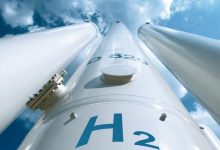Australian renewable energy developer CWP Renewables is among seven of the world’s biggest green hydrogen project developers and partners who have this week launched the Green Hydrogen Catapult initiative, which is targeting the deployment of 25GW through 2026.
CWP is involved in the massive Asia Renewable Energy Hub, which contemplates up to 26GW of wind and solar capacity to possibly service green hydrogen activities.
In addition to Australia’s CWP Renewables is Spanish electric utility Iberdrola, which recently bought Australian renewable company Infigen and is also building the country’s biggest wind and solar hybrid project in South Australia, and Norwegian chemical and fertiliser company Yara, which boasts a 20-year presence in Australia.
The seven founding partners are rounded out by Saudi Arabian renewable developer ACWA Power, Shanghai-based Envision, Danish power giant Ørsted, and Italian energy infrastructure company Snam.
The new global coalition will form the Green Hydrogen Catapult initiative, which aims to drive down the cost of green hydrogen to below $US2 per kilogram and accelerate the race to zero emissions by helping to transform energy across most carbon intensive industries such as power generation, chemicals, steelmaking, and shipping.
The Green Hydrogen Catapult will look to accelerate the scale and production of green hydrogen – which is hydrogen produced using electrolysis, powered by renewable electricity – 50-fold over the next six years, with a targeted deployment of 25GW of green hydrogen by 2026.
“Having led the race to deliver photovoltaic energy at well-below US$2 cents per kilowatt-hour, in certain geographies, we believe the collective ingenuity and entrepreneurship of the private sector can deliver green hydrogen at less than US$2 per kilogram within four years,” said Paddy Padmanathan, CEO of ACWA Power.
“From an industry perspective, we see no technical barriers to achieving this, so it’s time to get on with the virtuous cycle of cost reduction through scale up.”
The aim of driving down the cost of green hydrogen to below $US2 per kilogram is based on recent analysis by the global Hydrogen Council, which the Catapult believes is a potential tipping point that will make green hydrogen and its derivative fuels the energy source of choice across a range of sectors, including steel and fertiliser production, power generation, and long-range shipping.
For example, one of green hydrogen’s derivatives is green ammonia, which is being tested as a means to displace fossil fuels in thermal power generation.
According to research by Goldman Sachs, the green hydrogen market could be developed so as to provide 25% of the world’s energy needs by 2050 and become a $US10 trillion addressable market by 2050.
Goldman Sachs’ predictions are fundamentally underpinned by the recent emergence of national hydrogen strategies in countries such as Australia, Chile, Germany, the EU, Japan, New Zealand, Portugal, Spain and South Korea.
Australia’s hydrogen strategy, for example, has initially committed $AU370 million to advancing the country’s hydrogen industry, and though efforts failed to ensure a commitment to produce hydrogen only from renewable energy sources, the strategy nevertheless aims to “integrate more low-cost renewable generation, reduce dependence on imported fuels, and help reduce carbon emissions in Australia and around the world.”
Australia also hopes to establish ‘Hydrogen Hubs’ for production and export of hydrogen to the country’s major energy trading partners throughout the Asia Pacific region.
However, just last month, the University of New South Wales (UNSW) Sydney launched a study designed to test the viability of establishing a renewable energy-based hydrogen supply chain between Australia and Germany.
“The great renewable energy potential, infrastructure and energy exporting expertise, together with the manufacturing excellence and energy import needs of Germany, presents these countries with an ideal opportunity to establish a hydrogen value chain partnership that combines their comparative strengths and interests,” said Associate Professor Iain MacGill, who will lead the study.
“However, there are still considerable challenges, with associated uncertainties and risks, to overcome. This study will help us jointly plot a pathway to address these challenges and seize the opportunity for a vibrant renewable hydrogen sector in and across these countries, and beyond.”
Australian marine transportation company Global Energy Ventures is also pushing into the future of hydrogen in Australia, unveiling in October a new compressed hydrogen ship design which it claims will be able to store up to 2,000 tonnes of compressed hydrogen for marine transport, and which could play a significant role in exporting Australian-made hydrogen to partners around the world.
Unfortunately, the fact that Australia’s hydrogen strategy has not prioritised hydrogen created using renewable electricity risks turning Australia’s hydrogen industry into a stranded asset, with trading partners likely to be increasingly unwilling to accept the carbon taint as they look to decarbonise their own economies.
According to the German National Hydrogen Strategy released on 10 June 2020, “only hydrogen produced on the basis of renewable energies (‘green’ hydrogen) is sustainable in the long term.”
“Scaling up green hydrogen using existing infrastructure will be crucial to reaching climate goals,” said Marco Alverà, CEO of Snam, one of the seven founding partners of the Green Hydrogen Catapult.
“We believe that this new ‘coalition of the willing’ composed of leading companies in the private sector, with expertise, commitment and confidence in hydrogen’s potential, will play an important role in fostering cooperation and help to deliver the projects necessary to bring green hydrogen costs to the $2/kg tipping point even sooner than expected.”
In the long-term, the Green Hydrogen Catapult is aiming to align the production and use of green hydrogen with a trajectory that displaces fossil fuels at a rate consistent with achieving net zero global emissions by 2050 while helping to limit global temperature increases to 1.5 degrees Celsius.










